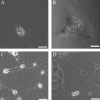Matrices with compliance comparable to that of brain tissue select neuronal over glial growth in mixed cortical cultures
- PMID: 16461391
- PMCID: PMC1414567
- DOI: 10.1529/biophysj.105.073114
Matrices with compliance comparable to that of brain tissue select neuronal over glial growth in mixed cortical cultures
Abstract
Cortical neurons and astrocytes respond strongly to changes in matrix rigidity when cultured on flexible substrates. In this study, existing polyacrylamide gel polymerization methods were modified into a novel method for making substrates capable of engaging specific cell-adhesion receptors. Embryonic cortical dissociations were cultured on polyacrylamide or fibrin gel scaffolds of varying compliance. On soft gels, astrocytes do not spread and have disorganized F-actin compared to the cytoskeletons of astrocytes on hard surfaces. Neurons, however, extend long neurites and polymerize actin filaments on both soft and hard gels. Compared to tissue culture plastic or stiff gel substrates coated with laminin, on which astrocytes overgrow neurons in mixed cultures, laminin-coated soft gels encourage attachment and growth of neurons while suppressing astrocyte growth. The number of astrocytes on soft gels is lower than on hard even in the absence of mitotic inhibitors normally used to temper the astrocyte population. Dissociated embryonic rat cortices grown on flexible fibrin gels, a biomaterial with potential use as an implant material, display a similar mechano-dependent difference in cell population. The stiffness of materials required for optimal neuronal growth, characterized by an elastic modulus of several hundred Pa, is in the range measured for intact rat brain. Together, these data emphasize the potential importance of material substrate stiffness as a design feature in the next generation of biomaterials intended to promote neuronal regeneration across a lesion in the central nervous system while simultaneously minimizing the ingrowth of astrocytes into the lesion area.
Figures





References
-
- Fawcett, J. W., and R. A. Asher. 1999. The glial scar and central nervous system repair. Brain Res. Bull. 49:377–391. - PubMed
-
- Horner, P. J., and F. H. Gage. 2000. Regenerating the damaged central nervous system. Nature. 407:963–970. - PubMed
-
- Janmey, P. A., and D. A. Weitz. 2004. Dealing with mechanics: mechanisms of force transduction in cells. Trends Biochem. Sci. 29:364–370. - PubMed
Publication types
MeSH terms
Substances
Grants and funding
LinkOut - more resources
Full Text Sources
Other Literature Sources

